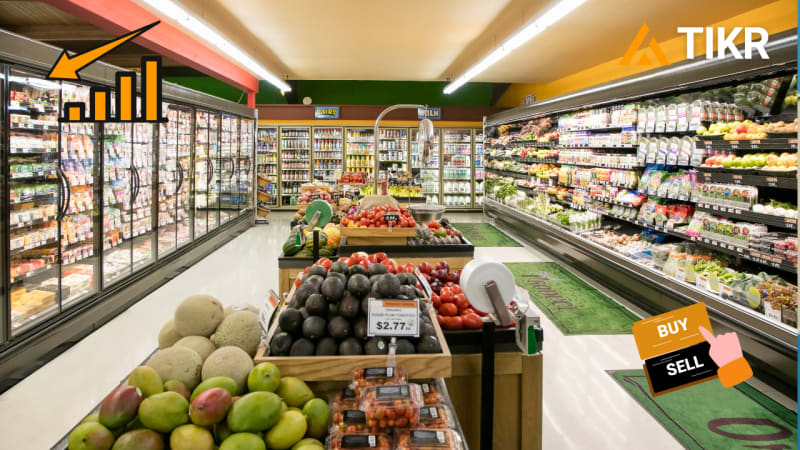Woolworths Group (WOW) is one of Australia’s most important retail operators, with leading positions in supermarkets, everyday needs, and hospitality. The business sits at the center of weekly consumer spending, which gives it a level of stability many sectors cannot match. But stability does not mean immunity. Over the past year, the stock has struggled as volumes softened, costs rose, and the company worked through pockets of operational pressure.
Discover how much upside your favorite stocks could have using TIKR’s new Valuation Model (It’s free) >>>
Unfortunately, fiscal year 2025 served as a reminder of the tight balance required in grocery retail. Food inflation cooled, shoppers traded down, and Woolworths had to invest more heavily in service, availability, and price positioning. Those decisions made sense for long-term loyalty, but they weighed on earnings in the short term. The market reacted accordingly, with shares pulling back despite stronger top-line resilience than many expected.

Management has made it clear that FY26 will be a reset year focused on consistency and cost discipline. The early signs point to a business steadily regaining its footing, with improving availability metrics, better inventory control, and a commitment to restoring margin stability. Investors now want to know whether this momentum can carry into the next phase of the cycle.
Quickly value any stock with TIKR’s powerful new Valuation Model (It’s free!) >>>
Financial Story
Woolworths delivered steady revenue performance in FY25, with group sales up modestly as supermarket demand held firm despite a softer consumer backdrop. Trading conditions were mixed across divisions, but the core Australian Food continued to anchor results. The broader challenge was profitability. Operating earnings were pressured by higher labor investment, store execution costs, and inflation that hit the company harder than expected in several categories.
| etric | FY25 | FY24 |
|---|---|---|
| Group Revenue | A$69.8B | A$67.6B |
| Group EBIT | A$2.83B | A$3.11B |
| Net Profit After Tax | A$1.55B | A$1.85B |
| Operating Cash Flow | A$4.56B | A$3.78B |
| Free Cash Flow | A$1.67B | A$0.42B |
| Dividend per Share | 94c | 96c |
EBIT declined year over year, reflecting these operational headwinds. While the drop was notable, the composition of the decline matters. Much of the margin pressure came from deliberate reinvestment aimed at stabilizing customer experience and protecting market share. Management has emphasized that FY25’s reset lays the groundwork for smoother earnings progression ahead, especially as cost initiatives start flowing through.
Cash generation improved meaningfully compared to the previous year. Free cash flow swung positive thanks to lower working capital use and more disciplined capital spending. The balance sheet remains well-positioned, giving Woolworths the flexibility to keep investing where needed. Dividend payments remain intact, supported by consistent underlying cash conversion.
Look up Woolworths’ full financial results & estimates (It’s free)>>>
Broader Market Context
Retail in Australia has been navigating a difficult period as households deal with higher living costs and shifting spending patterns. Grocers tend to hold up better than discretionary retailers, but even food operators have felt the effects of shoppers trading down, choosing private label, or adjusting basket sizes. The industry has also been under increased scrutiny over pricing, which has shaped the extent to which Woolworths can raise prices.
At the same time, major competitors have stepped up their own investments. Aldi continues to pressure value segments, while Coles has been focused on rebuilding availability after its own operational challenges. This competitive backdrop means execution matters even more for Woolworths, and FY26 will be a chance to show that recent reinvestment is producing the right operational outcomes.
1. Cost Discipline and Margin Repair
Woolworths entered FY25 with a clear goal: stabilize store execution and rebuild customer trust after several operational missteps. Those investments came with a cost. Labor spending increased, availability targets required more coordination, and inflation affected categories in ways that squeezed gross margins. The near-term impact on EBIT was unavoidable, but the underlying improvements are starting to show up in customer satisfaction and in-store consistency.
Looking ahead, management expects cost pressures to moderate and efficiency gains to contribute more meaningfully. Woolworths is targeting a smoother expense base, tighter rostering, and a better balance between price competitiveness and profit protection. If these initiatives continue to gain traction, the margin picture should look healthier in FY26 and beyond.
2. Food Retail Stability in a Slower Economy
Even in a challenging spending environment, supermarkets remain one of the most dependable parts of Australia’s consumer landscape. Woolworths continues to benefit from an extensive store network, strong brand recognition, and a wide product range that gives shoppers flexibility at multiple price points. Traffic trends have been steady, and private label performance remains a bright spot.
The broader challenge is that consumers are stretched, and trade-down behavior can weigh on the mix. Woolworths has been leaning into value messaging while still protecting quality and service. Over time, this balance tends to support both loyalty and stability. If volumes strengthen as household conditions improve, Woolworths stands to benefit from operating leverage and a more favorable mix.
Value stocks like Woolworths in less than 60 seconds with TIKR (It’s free) >>>
3. Digital, Online, and Loyalty Momentum
Digital adoption remains one of the most important drivers of long-term competitiveness. Woolworths’ e-commerce business remains resilient, with improving efficiency and stronger customer engagement through Everyday Rewards. The loyalty platform is playing an increasingly important role in frequency, basket size, and targeted promotions.
Management has indicated that technology investments will continue, but with a sharper eye on returns. Automation, fulfillment improvements, and AI-driven personalization are central to Woolworths’ next phase of growth. If executed well, these efforts could help expand margins, deepen customer stickiness, and position the company more competitively against both traditional and discount rivals.
The TIKR Takeaway

Woolworths is in a transition year. The business is stable, cash generation has improved, and operational execution is moving in the right direction. While FY25 earnings reflect a period of heavy reinvestment, the setup for FY26 and FY27 looks more balanced. TIKR’s long-term estimates point to steady revenue growth, modest margin recovery, and mid-single-digit earnings improvement as the consumer backdrop normalizes.
For investors tracking the company, TIKR’s valuation tools and financial history make it easy to compare scenarios, study margin trends, and understand how Woolworths’ earnings base has evolved. The data shows a business with durable demand, a strong balance sheet, and a clear plan to rebuild momentum.
Should You Buy, Sell, or Hold Woolworths Stock in 2025?
Woolworths offers defensive qualities, stable cash flow, and more precise execution heading into FY26. The stock is working through a reset period, but the medium-term setup looks healthier than the past year suggested. For now, sentiment improves as operational consistency returns and cost discipline strengthens.
How Much Upside Does Woolworths Stock Have From Here?
With TIKR’s new Valuation Model tool, you can estimate a stock’s potential share price in under a minute.
All it takes is three simple inputs:
- Revenue Growth
- Operating Margins
- Exit P/E Multiple
If you’re not sure what to enter, TIKR automatically fills in each input using analysts’ consensus estimates, giving you a quick, reliable starting point.
From there, TIKR calculates the potential share price and total returns under Bull, Base, and Bear scenarios so you can quickly see whether a stock looks undervalued or overvalued.
Estimate a company’s fair value instantly (Free with TIKR) >>>
Looking for New Opportunities?
- See what stocks billionaire investors are buying so you can follow the smart money.
- Analyze stocks in as little as 5 minutes with TIKR’s all-in-one, easy-to-use platform.
- The more rocks you overturn… the more opportunities you’ll uncover. Search 100K+ global stocks, global top investor holdings, and more with TIKR.
Disclaimer:
Please note that the articles on TIKR are not intended to serve as investment or financial advice from TIKR or our content team, nor are they recommendations to buy or sell any stocks. We create our content based on TIKR Terminal’s investment data and analysts’ estimates. Our analysis might not include recent company news or important updates. TIKR has no position in any stocks mentioned. Thank you for reading, and happy investing!








